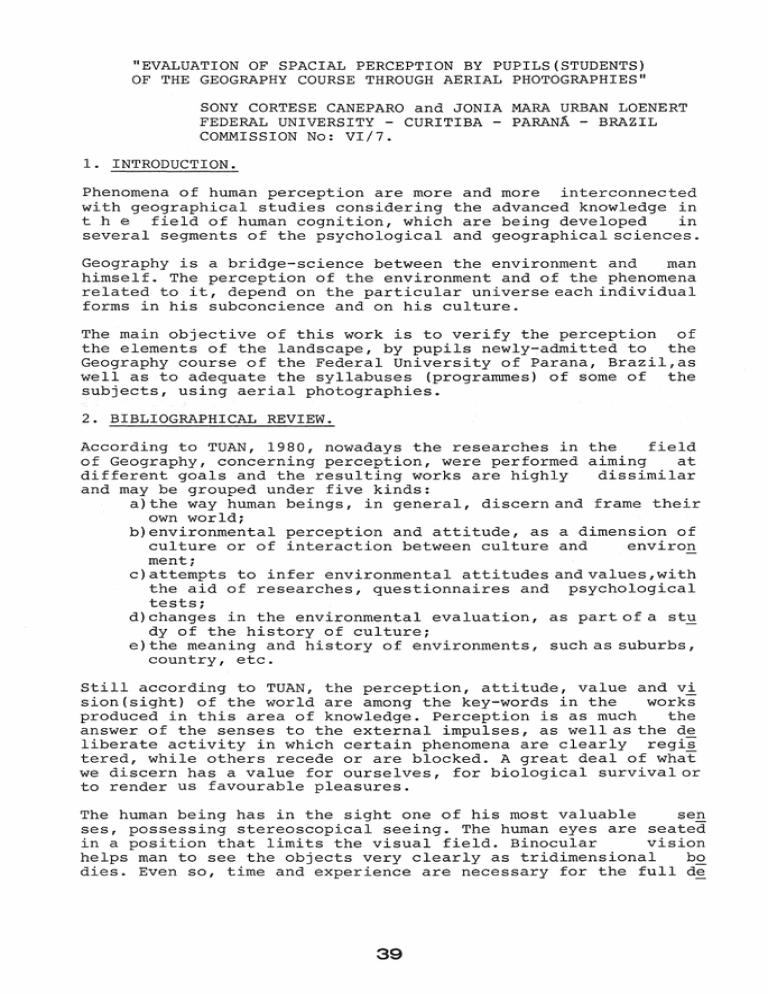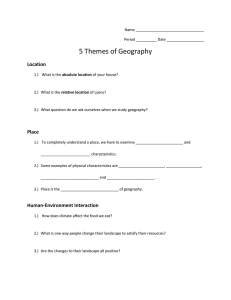"EVALUATION OF SPACIAL PERCEPTION BY ... OF THE GEOGRAPHY COURSE THROUGH ...
advertisement

"EVALUATION OF SPACIAL PERCEPTION BY PUPILS(STUDENTS) OF THE GEOGRAPHY COURSE THROUGH AERIAL PHOTOGRAPHIES" SONY CORTESE CANEPARO and JONIA MARA URBAN LOENERT FEDERAL UNIVERSITY - CURITIBA - PARANA - BRAZIL COMMISSION No: VI/7. 1. INTRODUCTION. Phenomena of human perception are more and more interconnected with geographical studies considering the advanced knowledge in t .h e field of human cognition, which are being developed in several segments of the psychological and geographical sciences. Geography is a bridge-science between the environment and man himself. The perception of the environment and of the phenomena rela ted to it, depend on the particular universe each individual forms in his subconcience and on his culture. The main objective of this work is to verify the perception of the elements of the landscape, by pupils newly-admitted to the Geography course of the Federal University of Parana, Brazil,as well as to adequate the syllabuses (programmes) of some of the subjects, using aerial photographies. 2. BIBLIOGRAPHICAL REVIEW. According to TUAN, 1980, nowadays the researches in the field of Geography, concerning perception, were performed aiming at different goals and the resulting works are highly dissimilar and may be grouped under five kinds: a)the way human beings, in general, discern and frame their own world; b)environmental perception and attitude, as a dimension of culture or of interaction between culture and environ menti c) attempts to infer environmental attitudes and values,with the aid of researches, questionnaires and psychological tests; d) changes in the environmental evaluation, as part of a stu dy of the history of culture; e) the meaning and history of environments, such as suburbs, country, etc. Still according to TUAN, the perception, attitude, value and vi sion(sight) of the world are among the key-words in the works produced in this area of knowledge. Perception is as much the answer of the senses to the external impulses, as well as the d~ liberate activity in which certain phenomena are clearly regi~ tered, while others recede or are blocked. A great deal of what we discern has a value for ourselves, for biological survival or to render us favourable pleasures. The human being has in the sight one of his most valuable sen ses, possessing stereoscopical seeing. The human eyes are seated in a position that limits the visual field. Binocular vision helps man to see the objects very clearly as tridimensional bo dies. Even so, time and experience are necessary for the full de 39 velopment of tridimensional vision. The scale of human perception is proportional to the acuteness and to the amplitude of our perceptive organs and to the purpose we are destining our observation. Nature consists mainly of discrete objects: trees, animals,rocks, human beings, etc. The human mind is adapted to organize the phenomena into segments and to set them in order according to its levels of experiments, which are transferred to the involving physical reality. The "MANUAL OF PHOTOGRAPHIC INTERPRETATION", 1975, of the AMERICAN SOCIETY OF PHOTOGRAMMETRY defines Photointerpretation as "the act of examining photographic images at the aim of identifyin objects and determining its meanings". It points out as well that aerial photographies are the raw material for photointerpretation. A great deal of information can be obtained from a sole aerial photo, due to the daily subsistence of man upon his habitat. The use of stereoscopes, which render the visualization of the con tents of images in the third dimension easier, offers a solid foun dation for photointerpretation. Besides, there are the elements of image interpretation, aiming at helping in interpretation, as objects may appear in photos in hundreds or thousands of varia tions: Size, Shape, Shadow, Tone and Color, Texture, Pattern, s1 te, Association and Resolution. Photointerpretation is connected to some branch of human knowledge, therefore not existing by itself; so, according to the American Society of Photogrammetry, it may be applied to t h e following sciences: Agronomy, Archaeology, Astronomy, Biology, Ecology,Geo graphy, Geology, etc. It is up to the photointerpreter to develop abilities through the study and inference of the phenomena to be exploited in the aerial photographies. Besides, there is a set of factors which regularize the quality of the works of photointerpretation: the person performing the work, types of photographies and available instruments; objective of the interpretation, scale and other specifications of the map and ready for use correlate knowledge. The great majority of subjects in which photo interpretation pro cesses are applied, undergo the following periods of probation: a) detection; b) recognition and identification; c) analysis; d) conclusion; e) classification; f) idealization. The first pre sents a direct relationship with the visibility of the objects to be interpreted, depending on: type of object, type of subject, type of scale and quality of photographies. The second step esta blishes "what the object is". Sometimes this step is called Phc to-Reading. The analysis outlines groups of objects having an identifiable individuality by photointerpretation. The process of conclusion is the most complex one as it is based on the con vergency of evidence, leading to classification, thus establish ing the identity of the surfaces or objects. Through idealiza tion, the lines of what is really seen on the photoimage are wor ked out .. 40 3. METHODOLOGICAL PROCEDURES. TO evaluate spacial perception, some students newly-admitted to the Geography course were selected. The material here used were couples of panchromatic aerial photographies, scale 1:25.000,cov~ ring an area situated in the southern part of the metropolitan re rion of Curitiba, Brazil. The students serving as samples are listed below. Demonstrative panel: Age - Sex - Subjects studied - Semester - Sub jects previously studied - Profession - Total of students(%). AGE 19 to 23 SEX M&F SUBJECTS STUDIED SEMES PROFESSION TER Rudiments of Phy sical Geography 2nd. Rudiments of Hu man Geography Primary teachers and students TOTAL OF STUDENTS (40) (percentage) 56% Rudiments of Bra zilian Geography 22 M&F and Rudiments of Phy sical Geography 2nd. 23 Students and Bank clerks 33% Students 11% Rudiments of Bra zili.an?GeographY 19 F and Rudiments of Phy sical Geography 2nd. 20 At first, some basic notions on photointerpretation, such as defi nition of photointerpretation, steps of photointerpretation, ele ments of recognition were offered as well as the procedures to ob tain the stereoscopic vision for photointerpretation. After that, each pupil received a pair of photos and, individually, placed them in stereoscopic so as to go with the photo-reading and photo interpretation in itself. 4. DISCUSSION OF THE RESULTS. With this study, one can classify the identified elements into ca tegories and calculate its percentage. The most remarked aspects in the photos were: cultivation areas (35%); roads (23%); vegeta tion (26%). However, some invironmental clearly visible elements were not fully detected: projected forms (3%) and aspects of the drainage network (13%). The seats of the properties were not iden tified. 41 This diagnosis demonstrated that the students admi tted to the cour se have a global vision of the landscape, only recognizing t h e elements that do not need a more systematical study, as for ins tance, geomorphology and urbane geography_ 5. RECOMMENDATIONS AND CONCLUSIONS. As the Geography course of the Federal University of Parana,Brazil is structured (framed) into eight semesters, it is recommended that the use of aerial photographies should be introduced gradual lye - The first period (semester) of the course (March to June) intro duces the student to the geographical and correlate knowledge. I~ this period the use of aerial photographies is not recommended,as the student has not yet acquired the necessary theoretical founda tion to discern spacial organization. Only in the second period (semester) (August to November) the use of aerial photographies in the subjects is recommended, provided they refer to areas fami liar to the student. Once the third period (semester) is started, the use of aerial pho tographies becomes more effective, as a cast of subjects allowing more efficiency in the use of such aids are introduced into the curriculum (syllabus). There we have subjects related to the field of Physical Geography and Human Geography, they being the basis for the perception of the environment as a whole. Aerial photographies may be used in the contents of the below lis ted subjects: Physical Geography I & II - studying the shapes of the Earth, hydr,Q. graphy and hydrology_ Human Geography I & II - studying the distribution of population and in the study of the organization of the agrarian space. Physical Geography of Brazil - studying the physical aspects,such as hydrography, projected forms geomorphology, soils and vegat~ tion. General cartography - in the working up of thematic cartogrammes. Geology I and Geomorphology - in the rocky distribution of t h e earthy crust and its correlation with forms. Human Geography of Brazil - studying the distribution of tion in Brazilian areas. popul~ Biological Geography - in the distribution and study of ecosystems. Urbane Geography - in the study of spacial settling of cities. Geography of Parana - studying the physical, human and economical aspects of the State. 42 Economical Geography - in the spacial distribution of and waftage. industries It is also recommended that aerial photographies should be used, in the first place, in subjects working with the contents of Hu man Geography, because one must take into consideration that the students have a previous knowledge of the elements familiar t 0 them in their everyday life. Immediately afterwards they may be introduced in the contents of the physical area about this already known universe. For the study involving the use of aerial photographies, the pupil should necessarily follow a subject, compulsary in his curriculum (syllabus), offering him the basic knowledge of photograrnmetry and photointerpretation. 6. Bibliographical References. - AMERICAN SOCIETY OF PHOTOGRAMMETRY. Manual of Photographis Interpretation.Virginia,1960. - TUAN, Y, FU. Topofilia. Sao Paulo, DIFEL, 1980. 43



